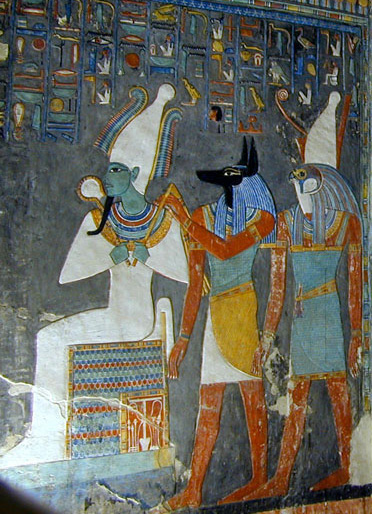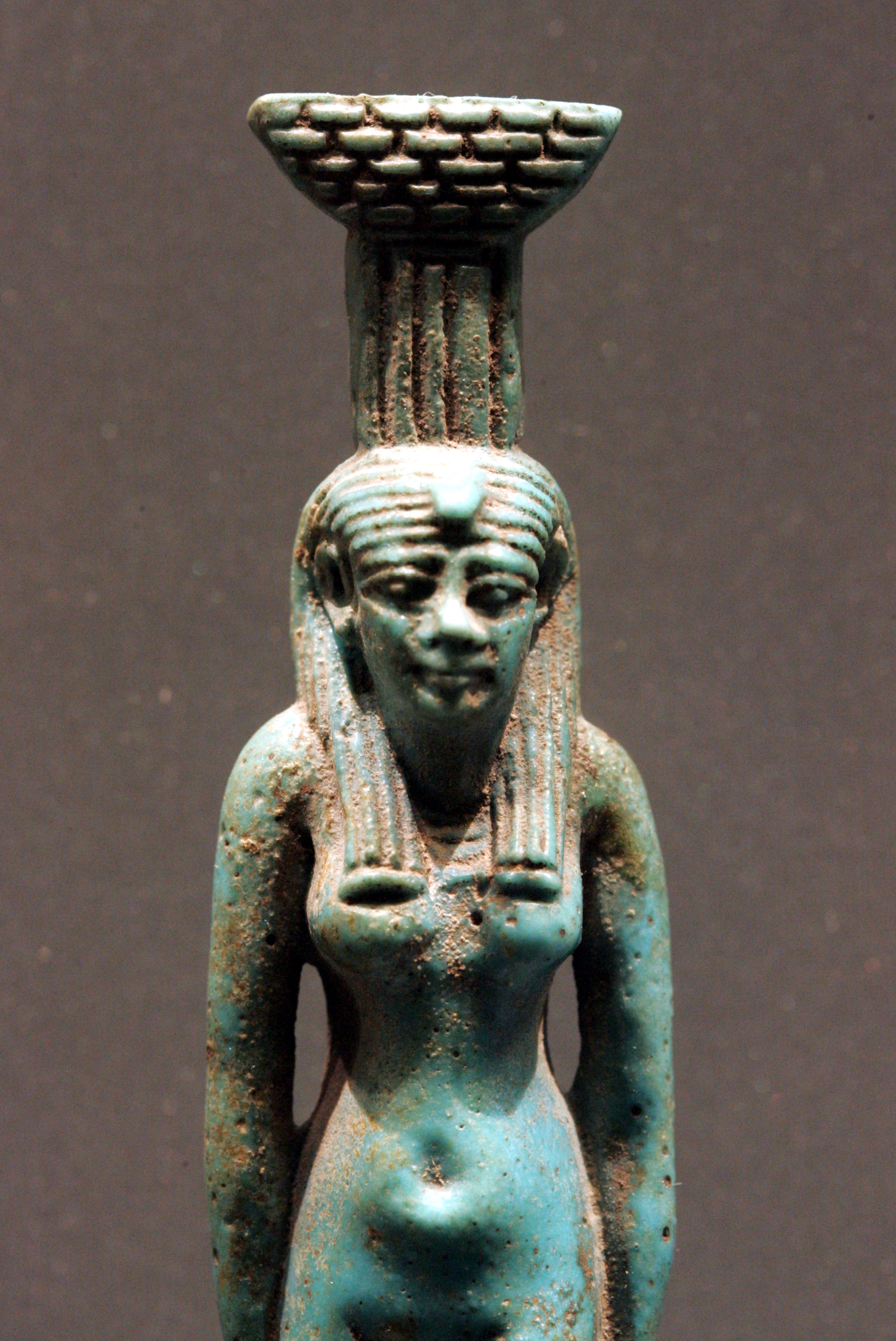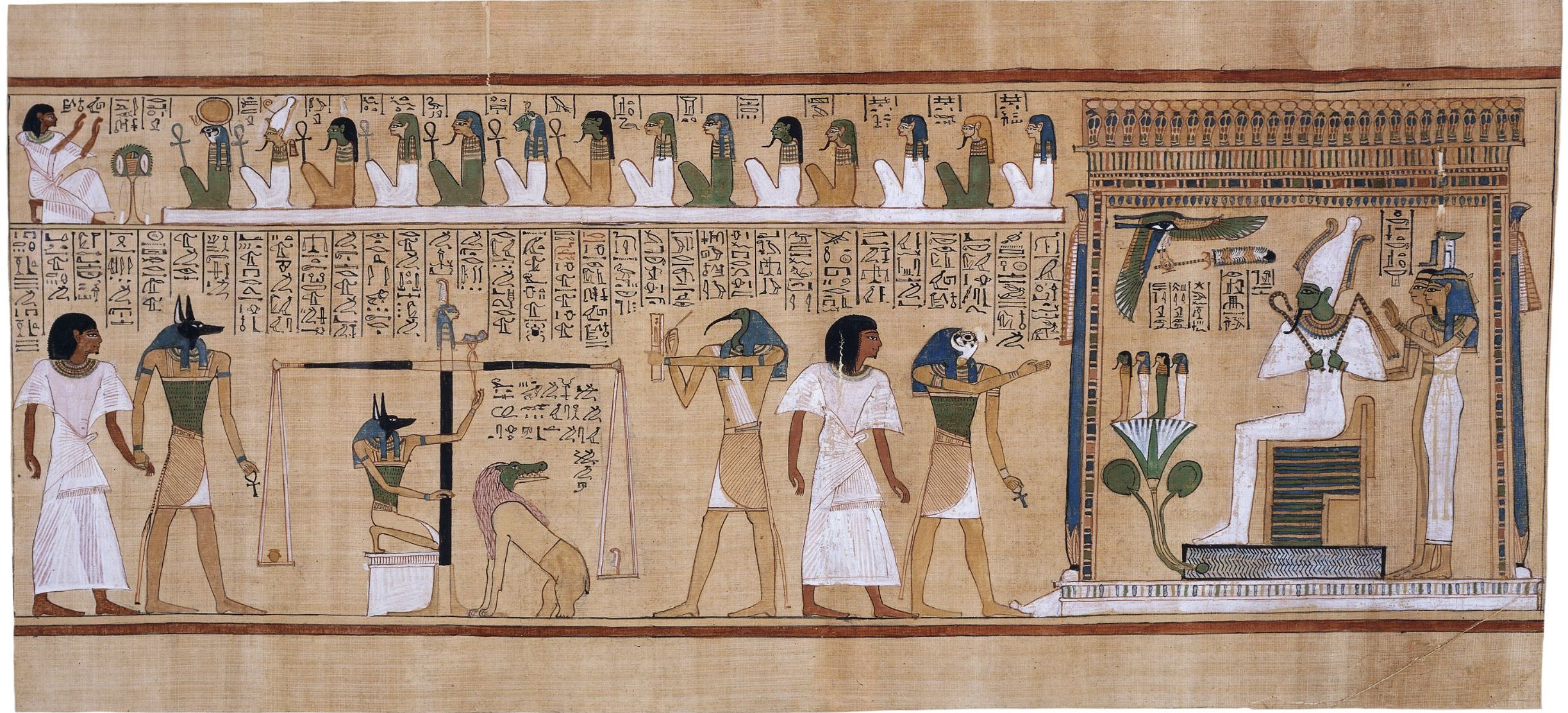|
Anubis
Anubis (; ), also known as Inpu, Inpw, Jnpw, or Anpu in Ancient Egyptian (), is the god of funerary rites, protector of graves, and guide to the underworld in ancient Egyptian religion, usually depicted as a canine or a man with a canine head. Like many ancient Egyptian deities, Anubis assumed different roles in various contexts. Depicted as a protector of graves as early as the First Dynasty (), Anubis was also an embalmer. By the Middle Kingdom (c. 2055–1650 BC) he was replaced by Osiris in his role as lord of the underworld. One of his prominent roles was as a god who ushered souls into the afterlife. He attended the weighing scale during the "Weighing of the Heart", in which it was determined whether a soul would be allowed to enter the realm of the dead. Anubis is one of the most frequently depicted and mentioned gods in the Egyptian pantheon; however, few major myths involved him. Anubis was depicted in black, a color that symbolized regeneration, life, the soil ... [...More Info...] [...Related Items...] OR: [Wikipedia] [Google] [Baidu] |
List Of Egyptian Gods
Ancient Egyptian deities were an integral part of ancient Egyptian religion and were worshiped for millennia. Many of them ruled over natural and social phenomena, as well as abstract concepts These gods and goddesses appear in virtually every aspect of ancient Egyptian civilization, and more than 1,500 of them are known by name. Many Egyptian texts mention deities' names without indicating their character or role, while other texts refer to specific deities without even stating their name, so a complete list of them is difficult to assemble. Major deities Gods * Aker – A god of Earth and the horizon * Amun – A creator god, Tutelary deity of the city of Thebes, and the preeminent deity in ancient Egypt during the New Kingdom * Anubis – The god of funerals, embalming and protector of the dead * Apis – A live Bull worshiped as a god at Memphis and seen as a manifestation of Ptah * Aten – Sun disk deity who became the focus of the monolatrous or monotheistic A ... [...More Info...] [...Related Items...] OR: [Wikipedia] [Google] [Baidu] |
Nephthys
Nephthys or Nebet-Het in ancient Egyptian () was a goddess in ancient Egyptian religion. A member of the Great Ennead of Heliopolis in Egyptian mythology, she was a daughter of Nut and Geb. Nephthys was typically paired with her sister Isis in funerary rites because of their role as protectors of the mummy, with her brother Osiris, and as the sister-wife of Set. She was associated with mourning, the night/darkness, service (specifically temples), childbirth, the dead, protection, magic, health, embalming, and beer. Etymology Nephthys is the Greek form of an epithet (transliterated as ''Nebet-hut'', ''Nebet-het'', ''Nebt-het'', from Egyptian ''nbt-ḥwt''). The origin of the goddess Nephthys is unclear but the literal translation of her name is usually given as ''Lady of the House'' or ''Lady of the Temple.'' This title, which may be more of an epithet describing her function than a given name, probably indicates the association of Nephthys with one particular temple or s ... [...More Info...] [...Related Items...] OR: [Wikipedia] [Google] [Baidu] |
Anput
Anput is a goddess in ancient Egyptian religion. Her name is written in hieroglyphs as ''jnpwt'' (reconstructed in Middle Egyptian as /ʔan.ˈpa.wat/ or /jan.ˈpa.wat/). In English, her name also is rendered as Anupet, Input, Inpewt, and Yineput. As the female counterpart of her husband, Anubis, who was known as ''jnpw'' to the Egyptians, Anput's name ends in a feminine "t" suffix when seen as ''jnpwt.'' She is also depicted as a woman, with a headdress showing a jackal recumbent upon a feather, as seen in the statue of the divine triad of Hathor, Menkaure, and Anput. She is occasionally depicted with the body of a woman and the head of a jackal, but this is very rare. As the consort of Anubis, Anput is a goddess of the dead, presiding over funerals and mummification. Additionally, she is a goddess of protection and also represented in relation to the desert, which was the realm of the dead for Ancient Egyptians. Unlike Anubis, Anput does not have a prominent role in Egyptian my ... [...More Info...] [...Related Items...] OR: [Wikipedia] [Google] [Baidu] |
Osiris
Osiris (, from Egyptian ''wikt:wsjr, wsjr'') was the ancient Egyptian deities, god of fertility, agriculture, the Ancient Egyptian religion#Afterlife, afterlife, the dead, resurrection, life, and vegetation in ancient Egyptian religion. He was classically depicted as a green-skinned deity with a Pharaoh, pharaoh's beard, partially mummy-wrapped at the legs, wearing a distinctive atef crown and holding a symbolic crook and flail. He was one of the first to be associated with the mummy wrap. When his brother Set (deity), Set cut him to pieces after killing him, with her sister Nephthys, Osiris' sister-wife, Isis, searched Egypt to find each part of Osiris. She collected all but one – Osiris’s genitalia. She then wrapped his body up, enabling him to return to life. Osiris was widely worshipped until the decline of ancient Egyptian religion during the Christianization of the Roman Empire, rise of Christianity in the Roman Empire. Osiris was at times considered the eldest son of ... [...More Info...] [...Related Items...] OR: [Wikipedia] [Google] [Baidu] |
Duat
The Duat or Tuat (Ancient Egyptian: Hieroglyph: 𓇽 romanized: dwꜣt) is a concept in ancient Egyptian mythology involving death. It is most often seen as a realm where people go after they die. Due to linguistic shifts within Ancient Egypt, the ''Duat'' has also been called Te () and Amenthes (). What is known of the ''Duat'' derives principally from funerary texts such as the '' Book of Gates'', the ''Book of Caverns'', the '' Coffin Texts'', the '' Amduat'', and the ''Book of the Dead,'' among many other sources. It is generally known best as a dark subterranean realm that not only houses the deceased, but a variety of deities. Common deities depicted in these texts are Osiris, Anubis, Thoth, Horus, and Maat in various forms. While all of these documents involve the ''Duat'', each of them fulfilled a different purpose and depict the ''Duat'' in a variety of unique ways. Overview This realm is most often depicted as a setting for a variety of rituals and mythological e ... [...More Info...] [...Related Items...] OR: [Wikipedia] [Google] [Baidu] |
Egyptian Pantheon
Ancient Egyptian deities are the God (male deity), gods and goddesses worshipped in ancient Egypt. The beliefs and rituals surrounding these gods formed the core of ancient Egyptian religion, which emerged sometime in prehistoric Egypt, prehistory. Deities represented natural phenomenon, natural forces and phenomena, and the Egyptians supported and appeased them through sacrifice, offerings and rituals so that these forces would continue to function according to ''maat'', or divine order. After the founding of the Egyptian state around 3100 BC, the authority to perform these tasks was controlled by the pharaoh, who claimed to be the gods' representative and managed the Egyptian temple, temples where the rituals were carried out. The gods' complex characteristics were expressed in Egyptian mythology, myths and in intricate relationships between deities: family ties, loose groups and hierarchies, and combinations of separate gods into one. Deities' diverse appearances in art ... [...More Info...] [...Related Items...] OR: [Wikipedia] [Google] [Baidu] |
Wepwawet
In Egyptian mythology, Wepwawet ( hieroglyphic ''wp-w3w.t''; also rendered Upuaut, Wep-wawet, Wepawet, Apuat, and Ophois) was originally a jackal deity of funerary rites, war, and royalty, whose cult centre was Asyut in Upper Egypt (Lycopolis in the Greco-Roman period). His name means ''opener of the ways'' and he is often depicted as a wolf standing at the prow of a solar-boat. Some interpret that Wepwawet was seen as a scout, going out to clear routes for the army to proceed forward. One inscription from the Sinai states that Wepwawet "opens the way" to king Sekhemkhet's victory.Remler, p.170 In royal and religious processions, Wepwawet was often depicted on the first standard, opening the way for subsequent standards. He also stands at the prow of the Barque of Ra, usually in human-headed form. Wepwawet originally was seen as a jackal, or, according to some, a wolf deity, with his cult center being at the '' Lycopolis'', (meaning ''city of wolves'' in Greek). He is one of t ... [...More Info...] [...Related Items...] OR: [Wikipedia] [Google] [Baidu] |
Ancient Egyptian Deities
Ancient Egyptian deities are the gods and goddesses worshipped in ancient Egypt. The beliefs and rituals surrounding these gods formed the core of ancient Egyptian religion, which emerged sometime in prehistory. Deities represented natural forces and phenomena, and the Egyptians supported and appeased them through offerings and rituals so that these forces would continue to function according to '' maat'', or divine order. After the founding of the Egyptian state around 3100 BC, the authority to perform these tasks was controlled by the pharaoh, who claimed to be the gods' representative and managed the temples where the rituals were carried out. The gods' complex characteristics were expressed in myths and in intricate relationships between deities: family ties, loose groups and hierarchies, and combinations of separate gods into one. Deities' diverse appearances in art of ancient Egypt, art—as animals, humans, objects, and combinations of different forms—also all ... [...More Info...] [...Related Items...] OR: [Wikipedia] [Google] [Baidu] |
Ancient Egyptian Religion
Ancient Egyptian religion was a complex system of Polytheism, polytheistic beliefs and rituals that formed an integral part of ancient Egyptian culture. It centered on the Egyptians' interactions with Ancient Egyptian deities, many deities believed to be present and in control of the world. About 1,500 deities are known. Rituals such as prayer and offerings were provided to the gods to gain their favor. Formal religious practice centered on the pharaohs, the rulers of Egypt, believed to possess divine powers by virtue of their positions. They acted as intermediaries between their people and the gods, and were obligated to sustain the gods through rituals and offerings so that they could maintain Ma'at, the order of the cosmos, and repel Isfet (Egyptian mythology), Isfet, which was chaos. The state dedicated enormous resources to religious rituals and to the construction of Egyptian temple, temples. Individuals could interact with the gods for their own purposes, appealing for hel ... [...More Info...] [...Related Items...] OR: [Wikipedia] [Google] [Baidu] |
Set (deity)
Set (; Egyptian language#Egyptological pronunciation, Egyptological: ''Sutekh - swtẖ ~ stẖ'' or: Seth ) is a deity, god of deserts, storms, disorder, violence, and foreigners in ancient Egyptian religion. In Ancient Greek, the god's name is given as (). Set had a positive role where he accompanied Ra on his solar barque, barque to repel Apep (Apophis), the serpent of Chaos. Set had a vital role as a reconciled combatant. He was lord of the Red Land (desert), where he was the balance to Horus' role as lord of the Black Land (fertile land). In the Osiris myth, the most important Egyptian mythology, Egyptian myth, Set is portrayed as the usurper who murdered and mutilated his own brother, Osiris. Osiris's sister-wife, Isis, reassembled his corpse and resurrection, resurrected her dead brother-husband with the help of the goddess Nephthys. The resurrection lasted long enough to conceive his son and heir, Horus. Horus sought revenge upon Set, and many of the ancient Egyptian myt ... [...More Info...] [...Related Items...] OR: [Wikipedia] [Google] [Baidu] |
Imiut Fetish
The Imiut fetish (''jmy-wt'') is a religious object that has been documented throughout the history of ancient Egypt. It was a stuffed, headless animal skin, often of a feline or bull. This fetish was tied by the tail to a pole, terminating in a lotus bud and inserted into a stand. The item was present in ancient Egyptian funerary rites from at least the earliest dynasties. Although its origin and purpose is unknown, the imiut fetish dates as far back as the First Dynasty (3100–2890 BC). History The earliest known depiction of the ''jmy-wt'' fetish is on a Predynastic lug handle dating to Naqada IIc-d, which appears to show the procedure by which intestines were extracted from a sacrificial bird and tied to the fetish. In the First Dynasty, the fetish appears on seals and labels during the reigns of kings Hor-Aha, Djer, Djet, and Den, where the ''jmy-wt'' is associated with ritual killings of prisoners. Another example found in 1914 by an expedition of the Metropolitan Mu ... [...More Info...] [...Related Items...] OR: [Wikipedia] [Google] [Baidu] |






